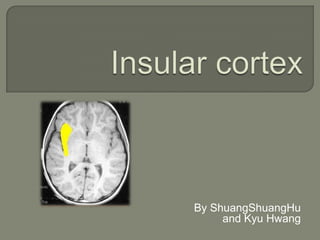Report
Share

Recommended
Recommended
More Related Content
What's hot
What's hot (14)
Medically unexplained symptoms by dr ajay nihalani

Medically unexplained symptoms by dr ajay nihalani
Viewers also liked
Viewers also liked (15)
Manali to Leh Tour Guide: What You Should Know Before Travelling

Manali to Leh Tour Guide: What You Should Know Before Travelling
Code: The Hidden Language of Computer Hardware and Software

Code: The Hidden Language of Computer Hardware and Software
8 Best Resorts in Wayanad Where You Would Love to Stay

8 Best Resorts in Wayanad Where You Would Love to Stay
Similar to Shuang shuang&q insular cortex
Similar to Shuang shuang&q insular cortex (20)
Brain neuroscience and the dynamics of addiction2012

Brain neuroscience and the dynamics of addiction2012
Introduction to the BioPsychoSocial approach to Addiction

Introduction to the BioPsychoSocial approach to Addiction
OCR Psychology 15 core studies G542 social science 

OCR Psychology 15 core studies G542 social science
IB Psychology Paper 1 Biological Level of Analysis

IB Psychology Paper 1 Biological Level of Analysis
Personality profile for drug addicts and non addicts in

Personality profile for drug addicts and non addicts in
10Consciousness© 2019 Cengage. All rights reserved.

10Consciousness© 2019 Cengage. All rights reserved.
10Consciousness© 2019 Cengage. All rights reserved.

10Consciousness© 2019 Cengage. All rights reserved.
Shuang shuang&q insular cortex
- 1. Insular cortex By ShuangShuangHu and Kyu Hwang
- 2. What is it? is located between the temporal lobe and parietal lobe is connected to the experience of emotions, the processing of tastes, the memory of procedures, the control of motor responses and interpersonal behaviour. negative emotions activate in this region.
- 3. The insular cortex comprises two main sections: the anterior and posterior regions AIC = the anterior insular cortex PIC= the posterior insular cortex Tasks: Such as: -motor tasks -amygdale activation -social emotions -language -interceptive awareness Tasks: Such as: -time and decision making -is related more to auditory function *perform a primary role in the processing and memory of emotional reactions.
- 4. Functions: Risky decision making Anxiety and neuroticism Interoceptive awareness Motor control Homeostasis Self Social emotions Emotions Salience
- 5. Study 1:Antonio Damasio’s“Choosing between the indistinguishable” study(2005) Aim: To determine, whether a person can have the preference for one taste over another without being able to distinguish between the two. Participants: Patient B, suffered from damage to the insular-cortex and a controlled patient (without damage to the insular-cortex) Procedure: Asked them to taste 38 drinks in succession (each drink was either a mixture of salt and water – “disgusting”, or sugar and water – “nice”), presented in random orders. Results:
- 6. Continuing… Procedure: Presented two drinks at a time: the salt drink and the sugar drink side by side. Patient B was asked to sip each and then to drink the one he preferred. On 19th trials, he chose the sugar drink. Findings: “The taste comparison likely provides patient B with an overt feeling that he would rather drink one solution than another, without any over knowledge of the taste experiences that would normally provide justification for this preference”
- 7. Study 2: Nicolas Danziger & colleagues“The empathic powers of those who can’t feel pain” study(2009) Aim: To see if patients with the inability to feel pain in real life can feel it vicariously Participants: 13 patients with the inability to feel pain 13 healthy controls Procedure: Participants had their brains scanned while they viewed videos of body parts being injured and people’s painful facial expressions. Results: Even though the patients had never felt pain themselves, the sight of other people’s pain triggered activity in the insular of their brains. Findings: Activity in insular cortex may reflect processing of the aversive emotional significance of what the patients were witnessing. Insular cortex is associated with psychological pain, induced by social exclusion or grief.
- 8. Study 3: Romantic Rejection Stimulates Areas of Brain Involved in Motivation, Reward and Addiction(2010) conducted by Fisher & Brown & others Aim: - to see if the pain of rejection by a romantic partner is related to brain activity associated with motivation, reward and addiction craving. Procedure: - researchers used functional magnetic resonance imaging (fMRI) to record brain activity in 15 college-age, men and women who had recently been rejected by their partners but reported that they were still in love. - participants were asked to take the Passionate Love Scale test. All participants scored high on the test. They said they spent more than 85% of their waking hours thinking of the person who rejected them. - participants viewed a photograph of their former partners. Then they completed a simple math exercise to distract them from their thoughts. Finally, they viewed a photograph of a familiar "neutral" person.
- 9. Results: While looking at the pictures of their formerpartners: It stimulated several key areas of the participants’ brains more than looking at photos of neutral people. The areas : - the ventral tegmental area -the nucleus accumbens and prefrontal cortex -the insular cortex and the anterior cingulate
- 10. Findings: romantic rejection is a specific form of addiction why the beloved is so difficult to give up why feelings related to romantic rejection can be hard to control a insight into extreme behaviors associated with rejection the pain of rejection by a romantic partner may be the result of activity in parts of the brain associated with motivation, reward and addiction cravings
- 11. Dysfunctions: Mood disorders Panic disorders PTSD Obsessive-compulsive disorders Eating disorders Schizophrenia
- 12. THANK YOU
